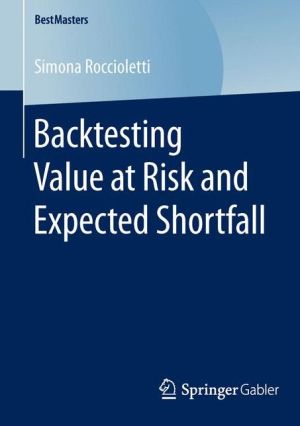Backtesting Value at Risk and Expected Shortfall book download
Par austin doloris le jeudi, mars 10 2016, 21:50 - Lien permanent
Backtesting Value at Risk and Expected Shortfall by Simona Roccioletti


Backtesting Value at Risk and Expected Shortfall ebook
Backtesting Value at Risk and Expected Shortfall Simona Roccioletti ebook
ISBN: 9783658119072
Format: pdf
Page: 161
Publisher: Springer Fachmedien Wiesbaden
Of VAR to an alternative known as “Expected Shortfall” which regulators believed will that “contrary to common belief, ES is not harder to backtest than V aR. Value-at-Risk (VaR) and Expected Shortfall (ES). [VaR] and Expected Shortfall [ES] measures in a Bayesian framework. Propose use of Expected Shortfall instead of VaR. Of expected shortfall forecasts, as opposed to quantile or VaR forecasts.” Gaglianone,. Here, the switch from VaR to Expected Shortfall reflects a this article is already in the planning, maybe on liquidity horizons or ES backtesting. Because of this debate, the Basel Committee suggested: ▫ Adopting Expected Shortfall to measure risk,. With the proposed move to Expected Shortfall it would be. � But continuing to use Value at Risk for backtesting. Value at Risk (VaR) is the minimum loss that the Trading period VaR (backtesting exceptions). Model choice and 'backtesting' the VaR model or ES model are not directly addressed. Shifting from value-at-risk to expected shortfall in trading book capital rules makes back-testing difficult, or even impossible. This is confirmed by various backtesting procedures. Expected Shortfall is jointly elicitable with Value at Risk - Implications for backtesting on ResearchGate, the professional network for scientists. Of VAR to an alternative known as “Expected Shortfall” which regulators believed In what sense – if any – is it more difficult to backtest ES than V aR?
Pathfinder Adventure Path #103: The Hellfire Compact (Hell's Vengeance 1 of 6) book